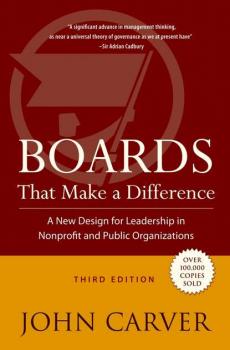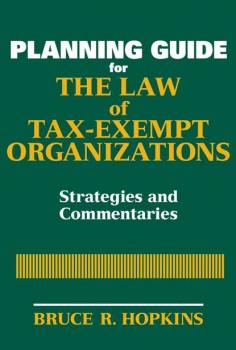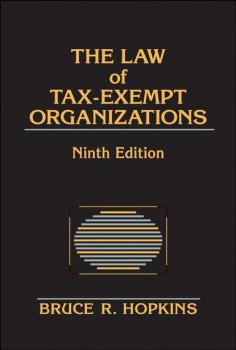Группа авторов
Список книг автора Группа авторовBoards That Make a Difference
In this revised and updated third edition, Carver continues to debunk the entrenched beliefs and habits that hobble boards and to replace them with his innovative approach to effective governance. This proven model offers an empowering and fundamental redesign of the board role and emphasizes values, vision, empowerment of both the board and staff, and strategic ability to lead leaders. Policy Governance gives board members and staff a new approach to board job design, board-staff relationships, the role of the chief executive, performance monitoring, and virtually every aspect of the board-management relationship. This latest edition has been updated and expanded to include explanatory diagrams that have been used by thousands of Carver's seminar participants. It also contains illustrative examples of Policy Governance model policies that have been created by real-world organizations. In addition, this third edition of Boards That Make a Difference includes a new chapter on model criticisms and the challenges of governance research.
Strategic Planning for Public and Nonprofit Organizations
When it was first published more than sixteen years ago, John Bryson's Strategic Planning for Public and Nonprofit Organizations introduced a new and thoughtful strategic planning model. Since then it has become the standard reference in the field. In this completely revised third edition, Bryson updates his perennial bestseller to help today’s leaders enhance organizational effectiveness. This new edition: Features the Strategy Change Cycle—a proven planning process used by a large number of organizations Offers detailed guidance on implementing the planning process and includes specific tools and techniques to make the process work in any organization Introduces new material on creating public value, stakeholder analysis, strategy mapping, balanced scorecards, collaboration, and more Includes information about the organizational designs that will encourage strategic thought and action throughout the entire organization Contains a wealth of updated examples and cases
Preventing Fraud in Nonprofit Organizations
IS YOUR NONPROFIT VULNERABLE TO FRAUD? Fraud or embezzlement discovered within a major corporation ultimately leads to front-page scandals and a few raised eyebrows. But the mere suggestion or evidence of fraud within a nonprofit can cause irreversible damage to its reputation, its support base, and, eventually, its very existence. Preventing Fraud in Nonprofit Organizations is the proactive manual your organization needs to detect fraud and prevent it from affecting your organization's bottom line and name. Brimming with details of hundreds of actual fraud and embezzlement schemes, it provides specific, practical advice on strengthening the areas in which your nonprofit may be most vulnerable. This hands-on guide shows nonprofit accountants, CFOs, financial consultants, board members, and managers how to: * Know the four consistent areas of high risk * Thoroughly evaluate their organization's system of internal controls * Assemble a fraud examination team * Document a fraud action plan * Expose weaknesses that could lead to fraud * Take corrective action to reduce the possibility of victimization Fraud deterrence is not exclusive to large corporations. Recommended reading for nonprofit professionals, Preventing Fraud in Nonprofit Organizations will motivate executives to take a fresh and intensive look at their organization's practices and act to protect from financial dishonesty.
The Tax Law of Charitable Giving
The Tax Law of Charitable Giving, Third Edition is completely revised, revamped, and updated. Written in plain English, it can help lawyers, managers, and development directors in tax-exempt organizations make sure they are up to date on all current regulations pertaining to charitable gifts, and that they are well prepared to make decisions about their organization’s fund-development program. Written by the country’s leading legal authority on tax-exempt organizations and charitable giving, this Third Edition features coverage of: New rules concerning charitable contributions of used vehicles and intellectual property New rules addressing the concepts of income and principal New characterization and ordering rules applicable to charitable remainder trusts Applying the public policy doctrine to the availability of the charitable deduction The impact of the tax cut legislation on the charitable giving rules The Tax Law of Charitable Giving, Third Edition is a go-to resource for nonprofit lawyers, nonprofit accountants, fundraising professionals, nonprofit executives, directors and managers, nonprofit consultants, financial planners, insurance companies, and corporate and (big) individual donors.
Human Resource Policies and Procedures for Nonprofit Organizations
Get the tools you need to build a successful human resource management system! Learn about organizational policies and procedures, nondiscrimination/affirmative action, recruitment, hiring, termination, compensation, supervision, employment conditions, administration, and volunteer policies–the framework for developing a comprehensive human resource management system for paid employees, volunteer workers, and outsourced work. This practical guide has handy features like a customizable CD-ROM full of sample policies, procedures, and forms that can be easily adapted to individual nonprofit organizations of any size, and it uses checklists extensively, enabling you to perform a step-by-step implementation of a complete, up-to-date human resource management system.
Planning Guide for the Law of Tax-Exempt Organizations
An indispensable reference tool, offering professionals hands-onlegal and tax planning tips An essential guide for professionals representing and advising tax-exempt organizations, Planning Guide for the Law of Tax-Exempt Organizations offers a wide variety of practical planning tips, guidance, and helpful information for better meeting clients' needs. This essential companion to the bestselling The Law of Tax-Exempt Organizations, Ninth Edition is a valuable, go-to resource for lawyers and accountants, directors and officers of nonprofit organizations, as well as managers and consultants for tax-exempt organizations. Written by the leading legal authority in the nonprofit sector, Planning Guide for the Law of Tax-Exempt Organizations features a digest of recent legislation, court opinions, and IRS public and private rulings, as well as checklists of forms and an inventory of penalties. Additionally, it features commentaries designed to provide guidance and perspective to tax-exempt professionals and organizations as to how to cope with the developments in the law affecting their practices and the operation of their programs.
Reliable Fundraising in Unreliable Times
Praise for Reliable Fundraising in Unreliable Times «Kim Klein has been a guru to social justice fundraisers for many years. She shows us by her efforts, and not just by her words, that it is possible to raise the money you need, no matter how marginal you feel or are considered in the larger society.» —Rinku Sen, executive director, Applied Research Center, New York, New York; author, Stir It Up and The Accidental American «With wisdom gleaned from over 30 years of experience, Kim Klein delivers her can-do message with wit, grace, and unabashed optimism—even in times like these. She taught us at JVP that there is still plenty of money out there; it's just unevenly distributed. Her consistent message: people give because we ask. Poking fun at money taboos, assuring us that fundraising is not that hard, Kim reminds us that the system is held in place by money: if we don't learn about it, we can't change it!» —Penny Rosenwasser, National Board, Jewish Voice for Peace, Oakland, California «This book is an extraordinary combination of philosophy and how to, all aimed at helping nonprofits build a movement for social justice. Kim distills three decades of fundraising and organizing experience into a book that will be helpful for novice and veteran alike.» —Lance Evoy, director, Institute for Community Development, Concordia University, Montreal, Quebec
The Law of Tax-Exempt Organizations
Written in plain English and supplemented annually, The Law of Tax-Exempt Organizations, Ninth Editioncan help the lawyers and managers of tax-exempt organizations make sure that they are up-to-date on all current regulations pertaining to tax-exempt organizations, and well-prepared to make decisions about their organization s actions and future.
Sarbanes-Oxley for Nonprofit Boards
The Sarbanes-Oxley (SOX) bar has been raised-is your nonprofit board up to the task? Nonprofit boards are in a fishbowl of scrutiny much like their private sector counterparts. With recent media focus on investigations of false charities, and more disturbingly, of household-name nonprofits that have abused donor trust by misdirecting donations, the heat is on the nonprofit board to rehabilitate its organizational profile. Encouraging boards to reclaim their role as the ultimate authority within their nonprofit, nationally recognized nonprofit expert Dr. Peggy Jackson supplies tips for leveraging the power and value of SOX requirements within the nonprofit organization. Containing sample documents, forms, and checklists to introduce best practices into any nonprofit organization, this complete guide is a practical, hands-on tool for equipping your nonprofit's board toward a higher quality of control. Relevant for both the large and small nonprofit organization, this must-have book effectively brings pragmatic clarity to a complex topic, and explains how to blend Sarbanes-Oxley requirements into the nonprofit organization, with topics including: Common factors that contribute to nonprofit board dysfunction Moving nonprofit governance into the twenty-first century Intervention techniques for moving your board forward Establishing strategies for lasting change Creating a platinum standard for governance Helping your nonprofit board understand and implement SOX requirements, Sarbanes-Oxley for Nonprofit Boards will be indispensable as a guide and will reinforce your nonprofit's financial structure and reputation.
Uncovering the Life of Your Dreams
An enlightening story. . . Scott Billings has a pretty good life, or so it appears. But something is missing for him. Like many others, he finds himself just going through the motions, sleepwalking through life, until an unexpected and unique encounter with a street beggar allows him to see the possibility of a new reality; a dream world that is more real than anything he’s ever experienced. It is a world that holds the answers to his questions about life . . . and his destiny. Based on the true story of the author’s transformational journey, Uncovering the Life of Your Dreams takes you on a journey of your own toward a more enlightened life filled with abundance, joy, and absolute freedom. This entertaining tale of the universal truths that connect us all offers a much-needed and timely message to help you awaken to a more conscious world. Enjoy a free online companion program, as well as access to a supportive community, to help you uncover the life of YOUR dreams.









